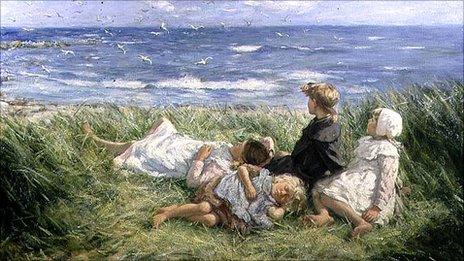Should councils cash in on art?
- Published
- comments

As local councils cut essential services to make ends meet, should they cash in on the paintings in their vaults? Or should public art be saved for future generations?
Inside Bolton Museum's storage sheds, on an industrial estate on the edge of town, bright yellow buckets are catching leaks from the roof and a small pile of plaster and wood has fallen off the ceiling.
The crumbling warehouses hold an endearingly random collection of relics from Bolton's past.
There is an original Spinning Jenny, boxes of roving bobbins, lamp posts, barrels, a local brewery's advertising statue and a dentists' chair.
The storage depot is in such disrepair that the council is selling it and needs to build a new one fast.
With no spare money in the main council budget, which is being cut by £60m over the next two years, it has been decided that 35 works from the council's fine art collection should be sold to meet the cost.
"We've been forced into the very difficult decision - that it's better to sacrifice part of the collection in order to preserve the majority of the collection," says Matthew Constantine, a manager at the council's museum service.
The first 11 paintings were sold last week, fetching £35,000.
Future sales include Seagulls and Sapphire Seas by Robert Gemmell Hutchison, worth up to £180,000, The Somnabulist by John Everett Millais, which could fetch up to £100,000, plus an etching and a lithograph by Pablo Picasso.
The works going under the hammer are a small fraction of the 1,100 oil paintings, watercolours and drawings in Bolton Council's collection, worth a total of £16m.
Around 50 of those are on display at any one time at the town's art gallery.
So at a time when the council, like others around the country, is making painful cuts to balance the books, why not let the valuers into the vaults and put the proceeds into frontline services?
"Our argument has always been there is greater value socially, and financially in some cases, derived from keeping and using that [collection] than there is from short-term selling off," Mr Constantine says.
"If it weren't for the extraordinary circumstances that the council finds itself in, then it [selling art] is something we wouldn't be doing.
"But we live in an age of difficult decisions and the art world is not an exception to that."
There are around 200,000 oil paintings in public ownership in the UK, according to the Public Catalogue Foundation, which is in the process of logging them all.
Around 10% of those are held by local authorities, the foundation estimates.
Galleries are only allowed to sell paintings in exceptional circumstances and if the money goes towards improving the remaining collection - such as by building a new storage facility - under Museums Association rules.
"Any income from a sale of collections should be spent on the care or use of the museum collection, and shouldn't be spent beyond that," says the association's head of policy Maurice Davies.
"The collection is a very long-term asset for the public benefit.
"We're very clear that a museum couldn't say, 'Oh dear we're going to have to make three staff redundant, we'll sell a picture to pay their salaries for a year.' That would be completely unacceptable."
Bolton councillor Stephen Pickup believes art collections are beneficial for a town, but that authorities should have the option of selling paintings to pay for essential services that are at "serious risk".
He says: "When councillors are being forced to make very serious decisions affecting the quality of life of residents, to the extent of the potential closure of libraries and care homes, and funding being withdrawn for many projects supporting our young people and voluntary groups, the sale of arts collections should certainly be given serious consideration."
In 2006, Bury Council raised £1.4m by selling LS Lowry's A Riverbank to plug a budget shortfall. They were thrown out of the Museums Association as a result.
At the time, council leader Wayne Campbell said the authority was anxious to ensure money went to vulnerable children, and that "people come before a picture".
When that painting was sold, there were more than 300 Lowry works in the store rooms of public collections in nearby Salford and Manchester, according to David Lee, editor of art magazine The Jackdaw.
Public art should be pooled and shared more effectively, he says - but works should not be sold to "cover the financial incompetence" of councillors.
"The future is bleak because eventually museums will be doing what museums do in America, which is selling stuff wholesale," Lee says. "I'm absolutely certain."
Lee regularly visits regional museums, but says he "very rarely" sees many people in them.
"I think local councillors are going to start asking museums to justify huge tranches of public money being spent on facilities which few people are interested in," he continues.
"They're going to see it as an elitist luxury and are going to use them as a source of plunder."
- Published23 June 2011
- Published29 November 2010
- Published25 October 2006
- Published1 April 2011
- Published14 December 2010
- Published25 November 2010